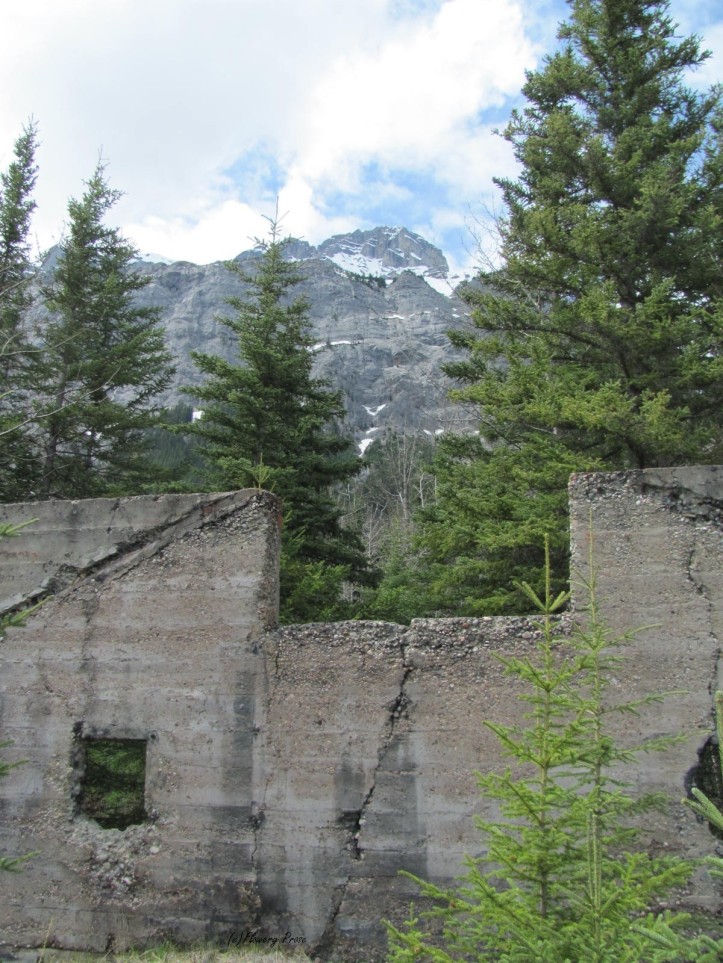My hubby and I took a quick dash up to Banff National Park this past weekend, and although we didn’t have time to do any serious hiking, we managed to walk some sites we’d never been to before. The most eye-opening place was the old townsite of Bankhead, a mining community that sprang up in 1903 to extract coal from nearby Cascade Mountain. Nestled against Lake Minnewanka, Bankhead rapidly boomed – at one point, the town had 900 residents, running water, electricity (and, according to one interpretive sign, tennis courts!).
The glory days all ended abruptly in 1922, when the lease of the parks land from the government ran out. High costs and declining production further sealed the deal, and the town was shuttered. By this time, Parks Canada was no longer interested in the mining business, either – its focus had shifted from exploitation of resources to conserving them. (Indeed, within the decade, mining would be banned in the national park). The citizens of Bankhead relocated to neighbouring towns: Banff, Canmore, or Calgary, and all of the buildings in the town were demolished.
Walking among the industrial ruins of Lower Bankhead gives you a sense of how large the mining operation was, and how many people it took to keep all of the machines running. Apparently, in 1911, when the mine was at peak production, 450 men yanked 500,000 tons of coal from the mountain.
While we picked our way around the piles of shiny coal slack near the former tipple, my hubby suddenly remarked that the plants growing in the black heaps looked an awful lot like rhubarb. An interpretive sign confirmed his suspicions – apparently, the immigrant labourers that kept the tipple running day and night had planted rhubarb in their gardens…and all these years later, it is reseeding itself and multiplying all over the landscape, shooting up architectural stalks and flowers, bearing fruit that no one will ever eat because it is carcinogenic. What an interesting living reminder of a past that most people have long forgotten. (It may also be a testament to the fact that rhubarb can grow pretty much anywhere!). 😉
Photo credit – #7 by R. Normandeau
Related articles
- Top 5 Backcountry Campgrounds in Banff National Park (thecampsiteblog.com)
- Still Waters by Jeff Clow (500px.com)
- Sunrise at Two Jake Lake in the Spring (hikingphoto.com)
- Sunken Treasure by C V (500px.com)
- Historic site reopens to visitors in Banff (globalnews.ca)
- rhubarb in the garden (thefoodintolerantteen.wordpress.com)
- Nosh: Savory Rhubarb-Onion Tart (beyondpaisley.net)
- Rhubarb Trifle Recipe (greatbritishchefs.com)
- Making Baked Apples stuffed with Rhubarb (greatbritishchefs.com)
- Spring Desserts: Rhubarb (and Strawberry) Crumble – Grace’s Recipe (acougarinthekitchen.com)







How resilient is rhubarb. I am encouraged there is hope for mine which I planted last year and which seems to be struggling. 🙂
It’s a very tough plant, actually – but it needs a good amount of moisture and plenty of nutrition (lots of compost). If they are new plants, don’t harvest stalks from them for at least the first year (or maybe two). I really hope your rhubarb does well for you! 🙂
Thanks for the compost reminder.
a lovely nostalgic post and suddenly the rhubarb rears its head and brings us back to earth. The miners were growing it as a vegetable and just 20 years after this closed, the USA reclassified rhubarb as a fruit!
Thanks so much! That’s awesome that you pointed out the whole craziness regarding rhubarb’s fruit/vegetable designation – it’s something many people are not aware of.
I thought you were kidding about the “fruit” classification. Sadly, that is not the case. Sigh.
Thanks for the pingback!
You’re quite welcome!
That whole rhubarb fruit-veggie thing is soooo confusing. Here in Canada, we usually call it a “fruit,” too, although I don’t know if we have any specific legal classification for it.
I’ve never stopped there, how interesting. Glad the G of C is focused more on preserving the area than mining it now.
It’s definitely worth the short walk; it’s really interesting! Hope you’re having a fabulous weekend! 🙂
Men may fade away, but rhubarb perseveres.
True, true! 🙂
Fascinating that the rhubarb still blooms.
It’s incredible! And it has spread crazily…I can’t believe it grows in that coal slack.
It is interesting to hear about a “New” old town that still boasts a hearty plant such as rhubarb. And the stone that is still there that marks the places where buildings once stood…travelling back in time…sometimes more fascinating than seeing the changes that have come from the past. Neat.
I really enjoyed our visit there…I love all that history. Hope you are all doing well, enjoying the sunshine! The kids must be nearly finished school and anxious to begin their summer vacation!
Such amazing scenery you got to enjoy on this trip. You’ve captured it beautifully.
Thanks so much! It’s so lovely to have the Rocky Mountains in our backyard! 🙂
As an Asian Canadian myself i was very emotional affected by the rhubarb plants – the only living legacy/evidence of site of hardship of early immigrants. (well besides the info plaques i guess)